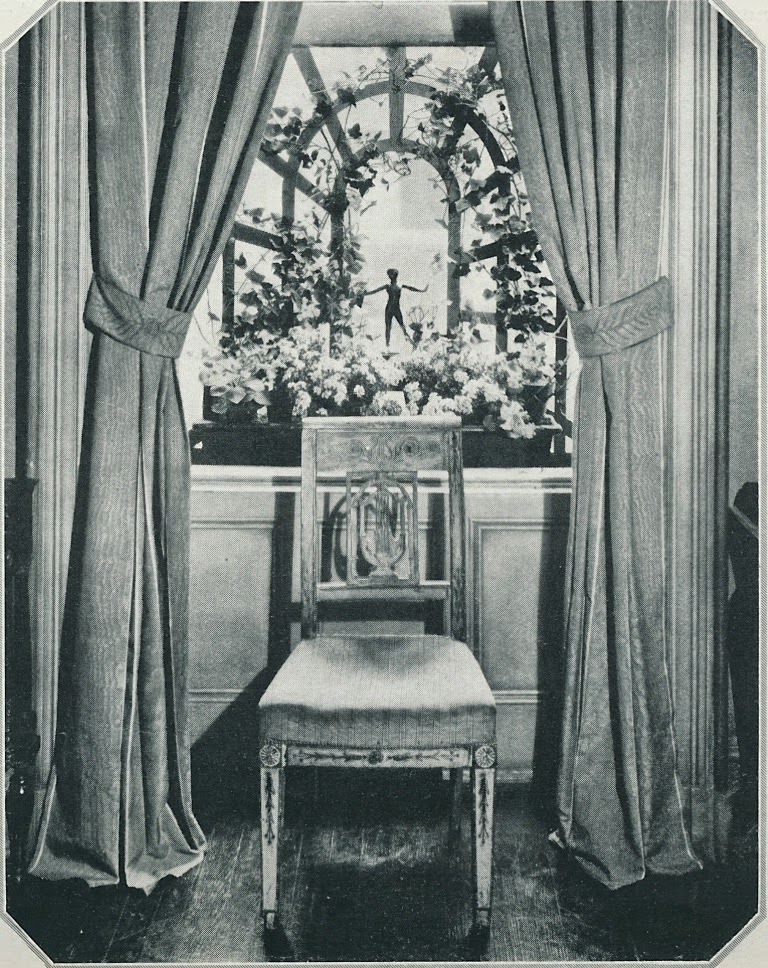Home »Unlabelled » Not-So-Garden Variety Rooms
Not-So-Garden Variety Rooms
4:13 AM
apa ya
While I was wide awake at 2 a.m. the other night, the most random image popped into my head: a photo, seen above, which shows the garden room of architect Archibald Brown's River House apartment. When I first saw the c. 1931 photo, which was taken by photographer Samuel H. Gottscho, I was intrigued by those sunken flower beds. How clever and, perhaps, how messy those indoor beds were. I would assume that the flowers were real, if the watering can placed alongside the bed was any indication. I wonder if this garden room was the work of Brown or that of Eleanor McMillen, the McMillen Inc. founder who later married Mr. Brown in 1934? I don't have the answer, but I did take this nocturnal ponderment as a sign that I needed to write a blog post about creative ways that homeowners have attempted to bring the outdoors inside.
The concept of creating an indoor garden space is one that I explore in my lecture on 20th-century design, which I have been giving to audiences around the country. Specifically, I discuss orangeries and winter garden rooms, both of which typically housed citrus trees, palm trees, and ferns. But if you look at interior photos from the 1920s and 1930s, you'll find all kinds of imaginative and, at times, theatrical ways that homeowners have introduced garden-like decorative elements to indoor spaces. In some cases, windows or trellises were employed as part of a ruse to fool people into thinking that they were viewing a real garden when, in fact, they were looking at painted scenes. Other homeowners took an easier route by simply using floor screens that had been painted with images of flowers or pastoral scenes.
One of the most enthusiastic champions of the indoor garden tableau was Dorothy Draper, who decorated quite a number of restaurants and hotels with elements typically seen outdoors: fountains; espalier; wrought-iron patio furniture; and topiaries. But Draper did not limit these indoor garden fantasies to her commercial projects. In her confidence-building, morale-boosting tome, Decorating is Fun!, Draper wrote a case history of "A Country Wren Who Turned into a City Sparrow". Poor Mrs. White was bereft at having to leave her country garden behind when her husband's job transferred them to the city- and to an apartment. After a time spent being "positively mopey", Mrs. White had a stroke of genius: she turned her living room's bay window, which was south-facing (hurray!), into a garden oasis by building a short door sill in front of the window, laying the floor with linoleum, scattering pebbles over the floor, and placing two tall rubber plants and an assortment of other potted plants onto the pebbles. Further heightening the garden feel were red trellis, which was placed on the walls surrounding the window, and a "lovely old English bird cage with two happily married bullfinches in it." The result was such that, "Mrs. White likes her sunny little garden almost better than the one she left behind in the country."
So you see, no matter where you live, you too can create an indoor garden for yourself. All it takes is a little creativity, some know-how, and perhaps a bullfinch or two.
A corner of William Paley's Beekman Place apartment was dedicated to a mini-garden, one which appears to be overflowing with ferns and sundry plants. (Photo taken by Samuel H. Gottscho in 1936; from the collections of the Museum of the City of New York.)
A small fountain and lots of plants in the studio of interior decorator Emma Romeyn. (1939; Gottscho-Schleisner, Inc.; from the collections of the Museum of the City of New York.)
A rendering of a dining room decorated by Diane Tate & Marian Hall. The most conventional way of giving a room a garden feel is by displaying flowering plants in front of a window, as seen here.
In the Gallery of the Armour House, Lake Bluff, Illinois, a mass of potted plants and hand-painted palm fronds on the walls echo the view beyond the front door. Frances Elkins was the decorator.
In this 1920s-era room, a trellis and flower box were placed outside of the window. Here, the garden element is not quite indoors, but almost. Paula Robertson, decorator.
In this room by Wanamaker, outdoor garden scenes of Venice were created through the use of trellised arches and trompe l'oeil-painted roller blinds. The roller blinds evidently covered up windows that displayed "unsightly city views."
In the Fifth Avenue residence of Walter Seligman, the dining room walls were hung with a floral-print fabric, while the backs of the double-doors, which are seen open, were painted with bucolic scenes that continued into the hall beyond the dining room. It almost looks as if one could walk from the dining room straight into the outdoors. (C. 1930, Samuel H. Gottscho photographer. From the collections of the Museum of the City of New York.)
A far easier method of decorating with budding blooms was the painted screen. This example was painted by Etienne Drian around 1938.
A dining room at the Carlyle Hotel, c. 1938. I assume that Dorothy Draper was responsible for this considering that she decorated the hotel in 1930. (Gottscho-Schleisner, Inc. From the collections of the Museum of the City of New York.)
The two photos seen above show the Garden Lounge at Hampshire House, which was also decorated by Draper. The espaliered fruit trees are faux.
And yet another Draper creation: the Peacock Court at San Francisco's Mark Hopkins Hotel.
Photo at top and others as noted: Samuel H. Gottscho photographer, from the Collections of the Museum of the City of New York. Tate & Hall, Robertson, and Wanamaker photos from "The Book of Colour Schemes"; Elkins photo from "Frances Elkins" by Stephen Salny; Draper photos from "In the Pink" by Carleton Varney; Drian screen photo from Martin Battersby's "The Decorative Thirties".



















No comments:
Post a Comment